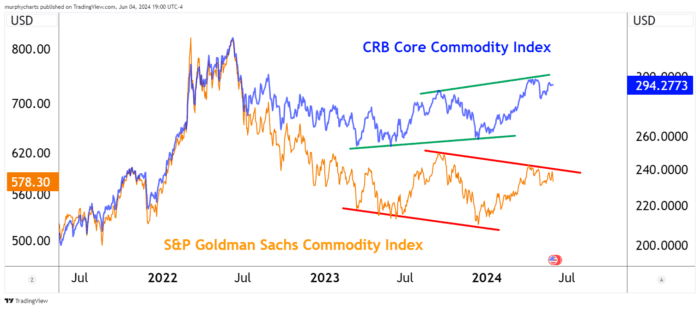1/ Tale of Two Commodity Indices
2/ Quality Outperforming
3/ Low Vol vs. High Beta
Investopedia is partnering with CMT Association on this newsletter. The contents of this newsletter are for informational and educational purposes only, however, and do not constitute investing advice. The guest authors, which may sell research to investors, and may trade or hold positions in securities mentioned herein do not represent the views of CMT Association or Investopedia. Please consult a financial advisor for investment recommendations and services.
1/ Tale of Two Commodity Indices
The below chart highlights two well-known Commodity indices – the CRB Index (CRB) and the S&P Goldman Sachs Commodity Index (SPGSCI). Both track a basket of commodities, but they follow a very different methodology. The most notable is exposure to agricultural commodities. The CRB consists of over 2x the exposure to agricultural commodities than SPGSCI (40% vs. 18%). SPGSCI also maintains 10-15% more energy commodity exposure – making it much more sensitive to oil prices. It’s no surprise the CRB is outperforming in this environment. The CRB saw a less severe drawdown in ’22-‘23, and is fully participating to the upside in 2024.

2/ Quality Outperforming
Valuations in small-caps relative to large-caps may look attractive right now – but the price trend remains firmly in favor of the big guys. The below chart highlights the 1-year price path of mega-cap stocks versus small-cap stocks. The ratio saw new 52-week highs yesterday and is displaying no sign of letting up.

3/ Low Vol vs. High Beta
The Z-score is a statistical measure that highlights how many standard deviations away price is from the mean of the distribution. I particularly find value in applying the indicator to ratio charts. The below ratio is the S&P 500 Low Volatility Index versus S&P 500 High Beta Index. Stocks with low price volatility tend to also have stable earnings growth and are often found in defensive sectors such as Consumer Staples or Utilities. High beta stocks on the other hand, are more volatile than your average stock in both price and earnings. The ratio is currently trading at support and coming off its third -2 Z-score reading in the last few years. Z-score coupled with other indicators, can help identify asset volatility and overbought/oversold conditions.

About This Week’s Author
Shane Murphy, CMT has been a CMT Charterholder since 2022. He is currently a Wealth Management Associate at Michael Roberts Associates, Inc. where he assists in portfolio construction, investment research, and financial planning.
————————————
Originally posted on June 5th, 2024
Disclosure: Investopedia
Investopedia.com: The comments, opinions and analyses expressed herein are for informational purposes only and should not be considered individual investment advice or recommendations to invest in any security or to adopt any investment strategy. While we believe the information provided herein is reliable, we do not warrant its accuracy or completeness. The views and strategies described on our content may not be suitable for all investors. Because market and economic conditions are subject to rapid change, all comments, opinions and analyses contained within our content are rendered as of the date of the posting and may change without notice. The material is not intended as a complete analysis of every material fact regarding any country, region, market, industry, investment or strategy. This information is intended for US residents only.
Disclosure: Interactive Brokers
Information posted on IBKR Campus that is provided by third-parties does NOT constitute a recommendation that you should contract for the services of that third party. Third-party participants who contribute to IBKR Campus are independent of Interactive Brokers and Interactive Brokers does not make any representations or warranties concerning the services offered, their past or future performance, or the accuracy of the information provided by the third party. Past performance is no guarantee of future results.
This material is from Investopedia and is being posted with its permission. The views expressed in this material are solely those of the author and/or Investopedia and Interactive Brokers is not endorsing or recommending any investment or trading discussed in the material. This material is not and should not be construed as an offer to buy or sell any security. It should not be construed as research or investment advice or a recommendation to buy, sell or hold any security or commodity. This material does not and is not intended to take into account the particular financial conditions, investment objectives or requirements of individual customers. Before acting on this material, you should consider whether it is suitable for your particular circumstances and, as necessary, seek professional advice.


















Join The Conversation
If you have a general question, it may already be covered in our FAQs. If you have an account-specific question or concern, please reach out to Client Services.